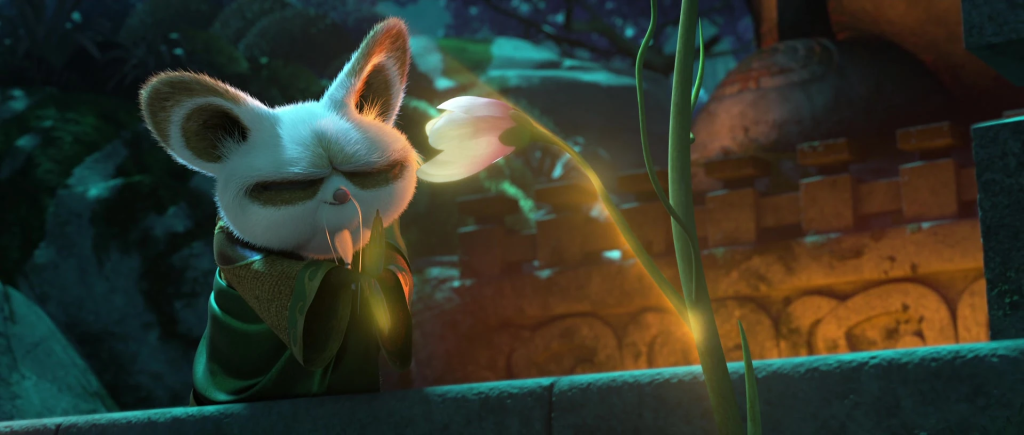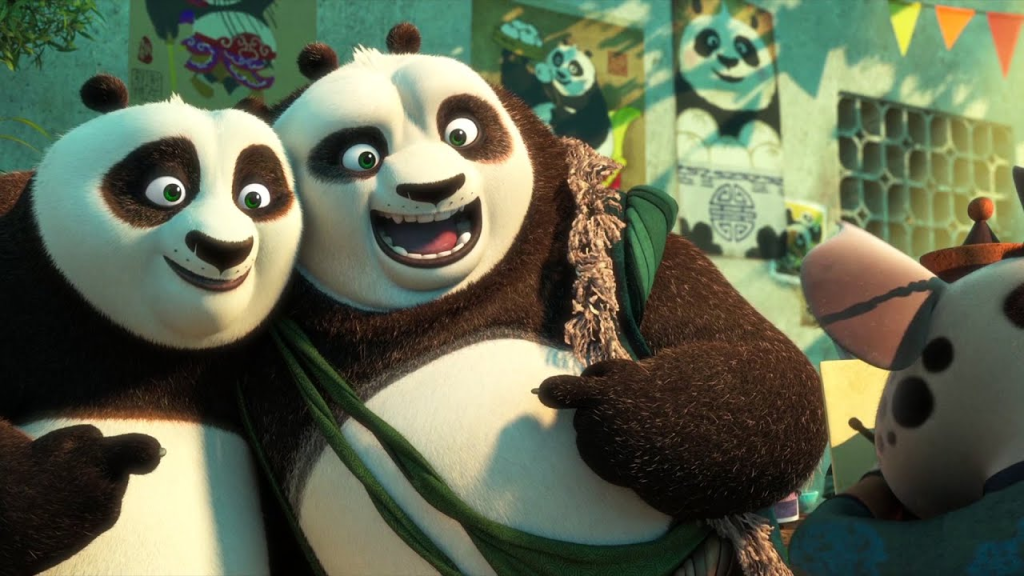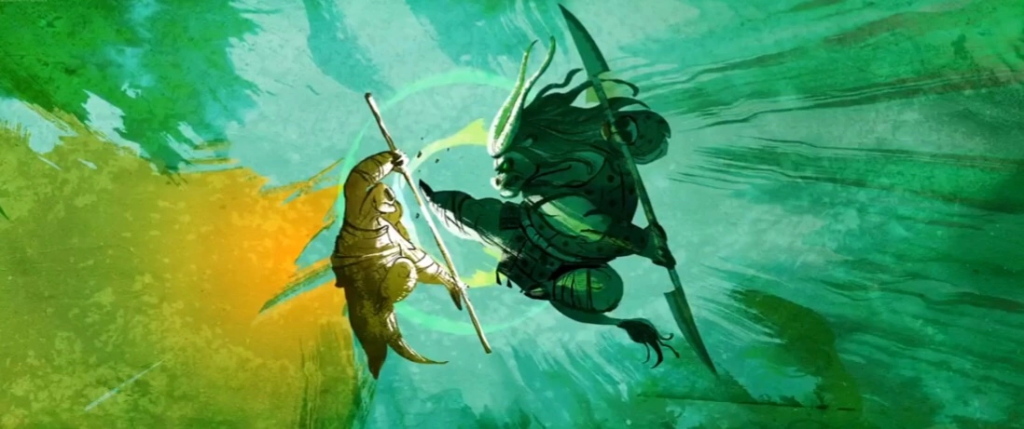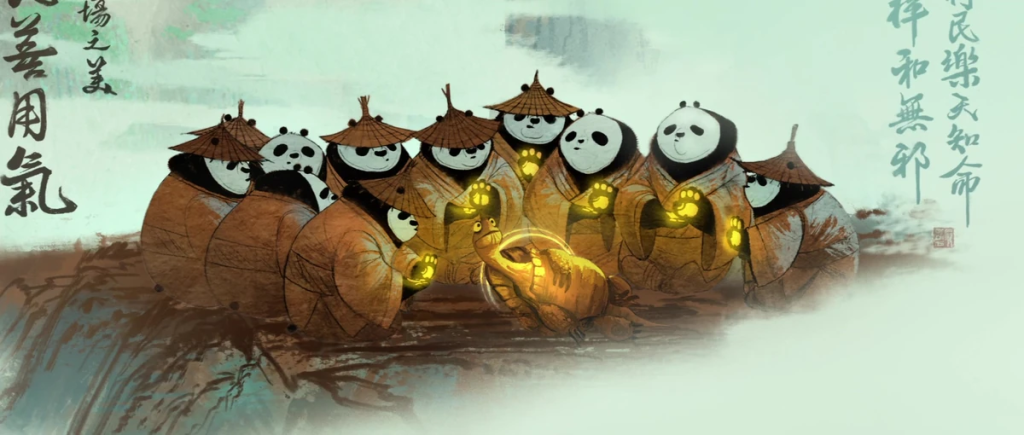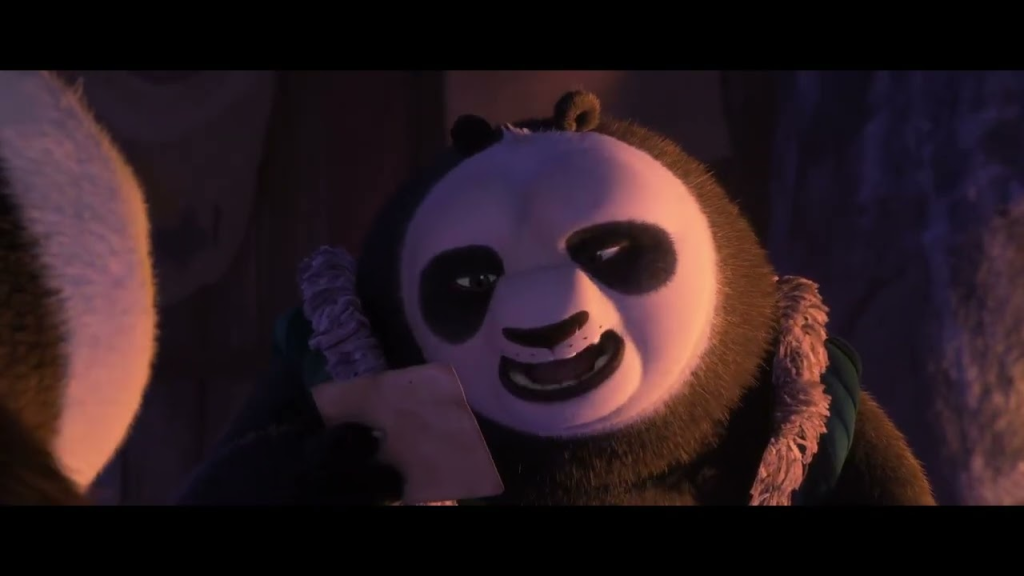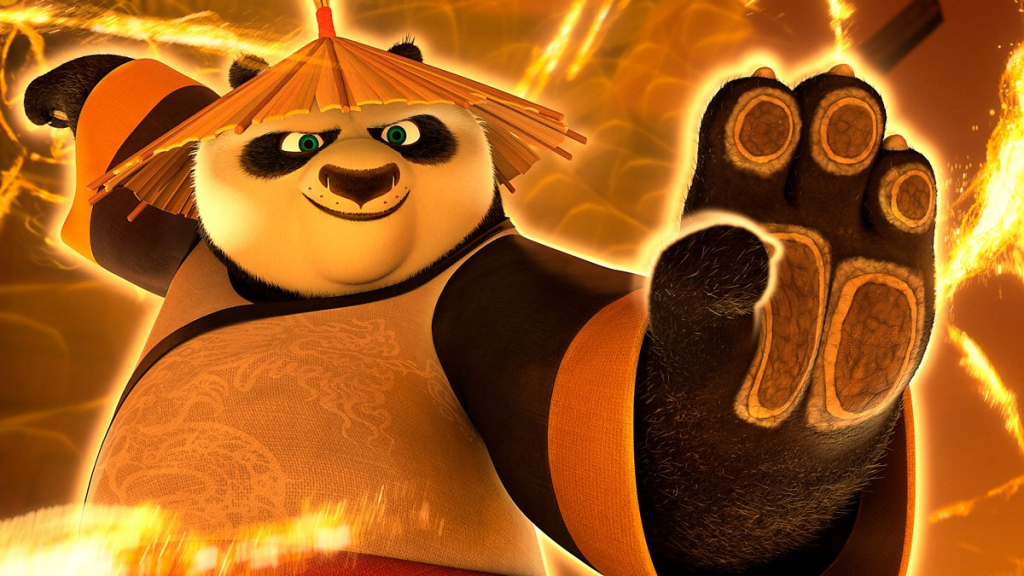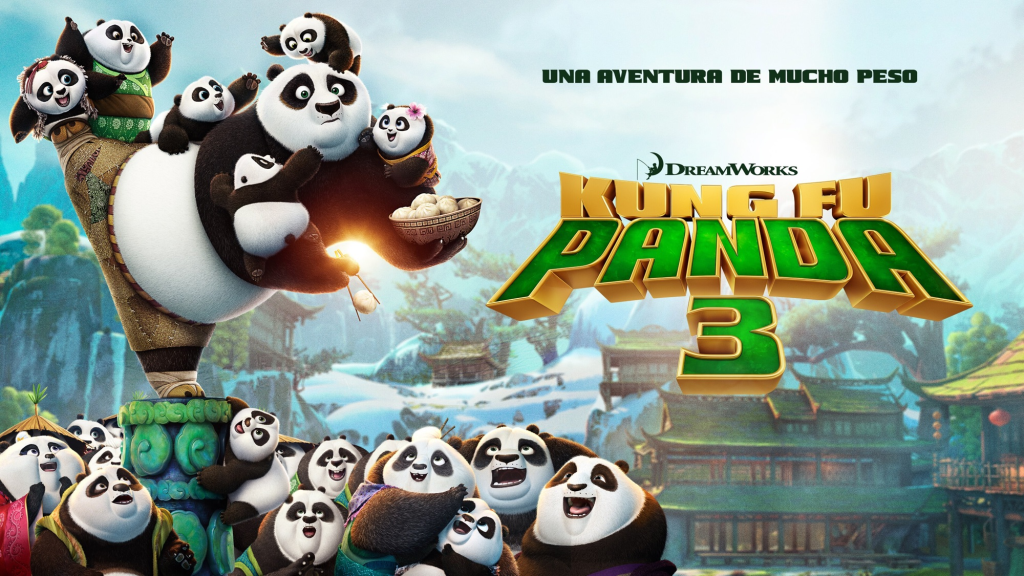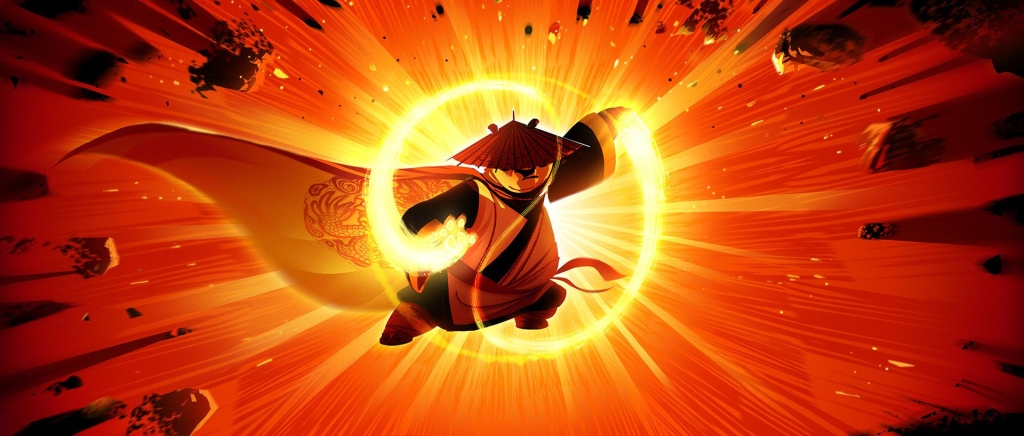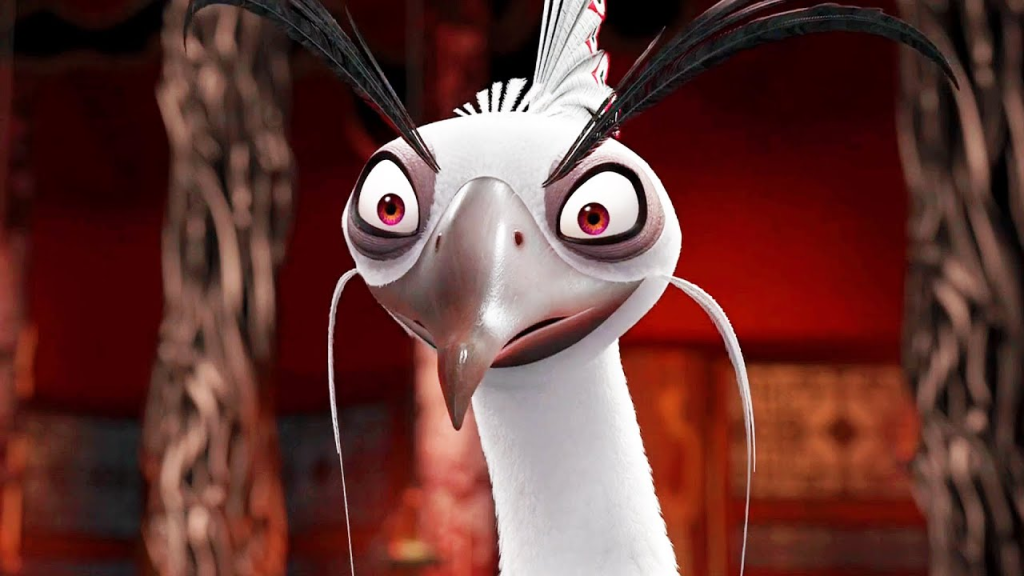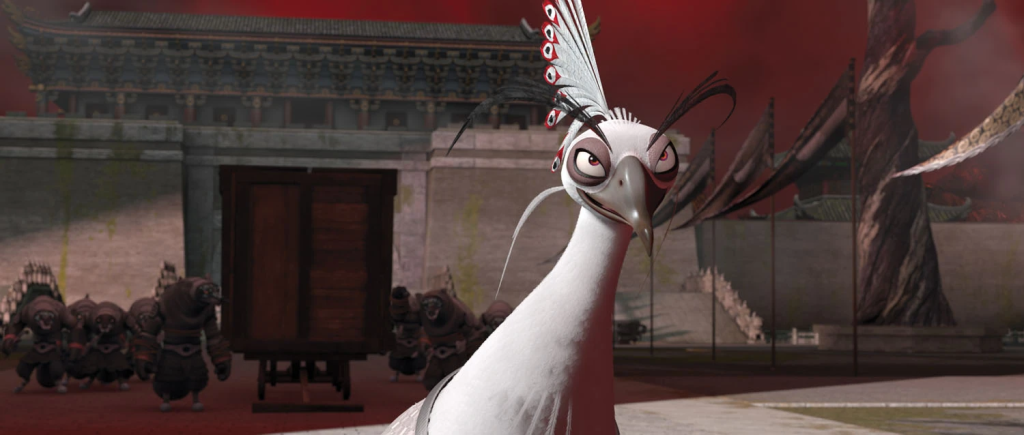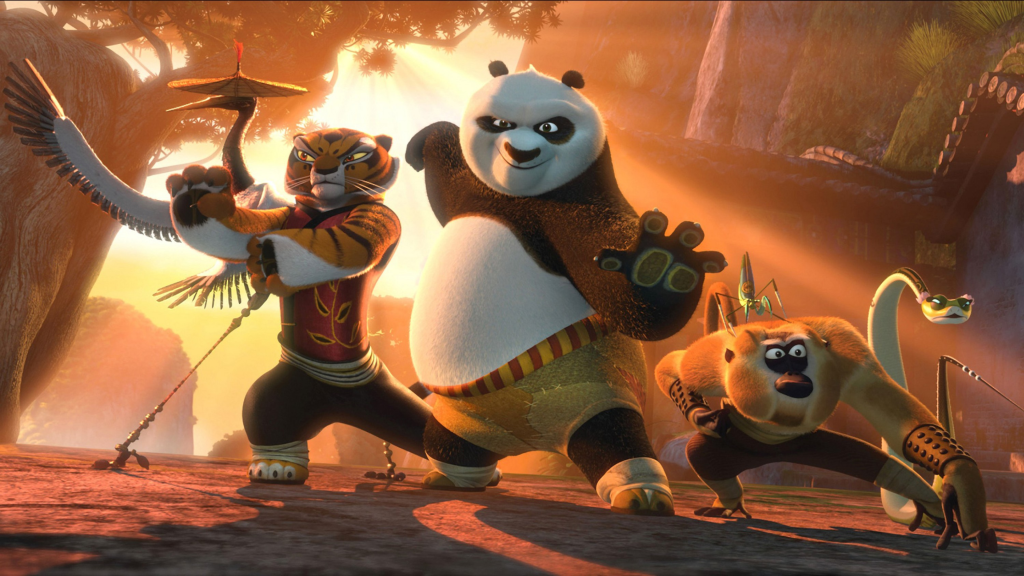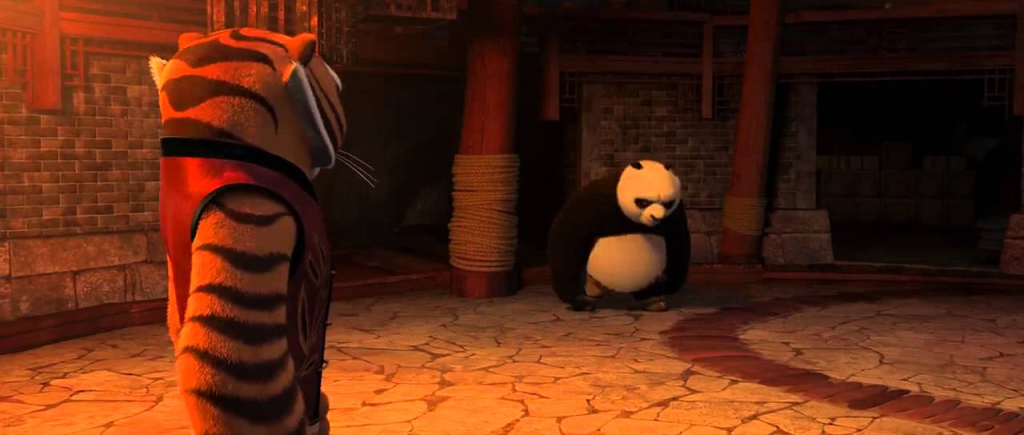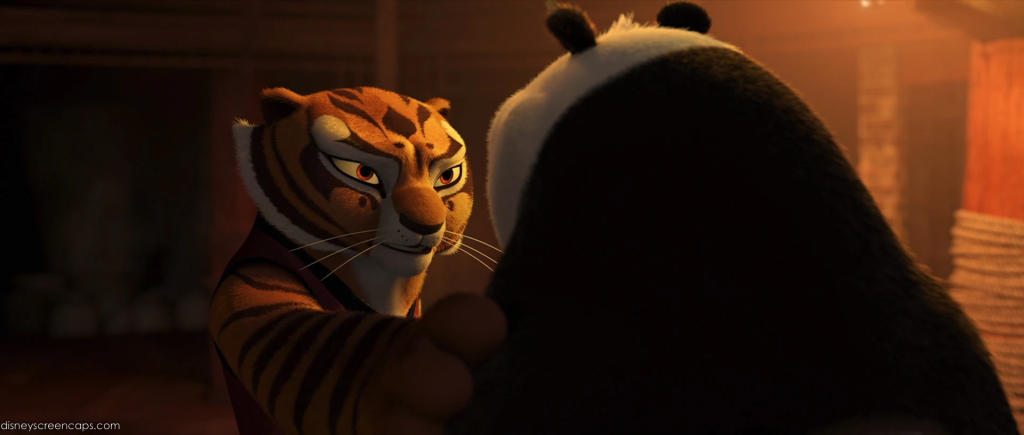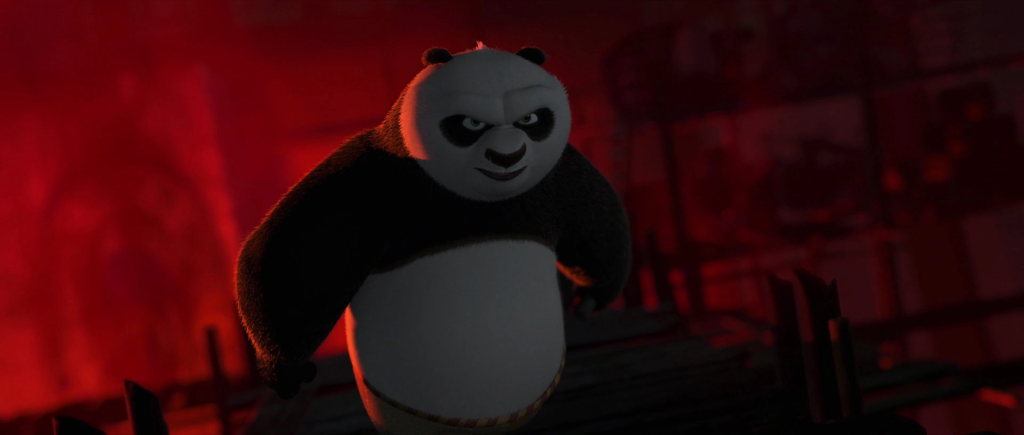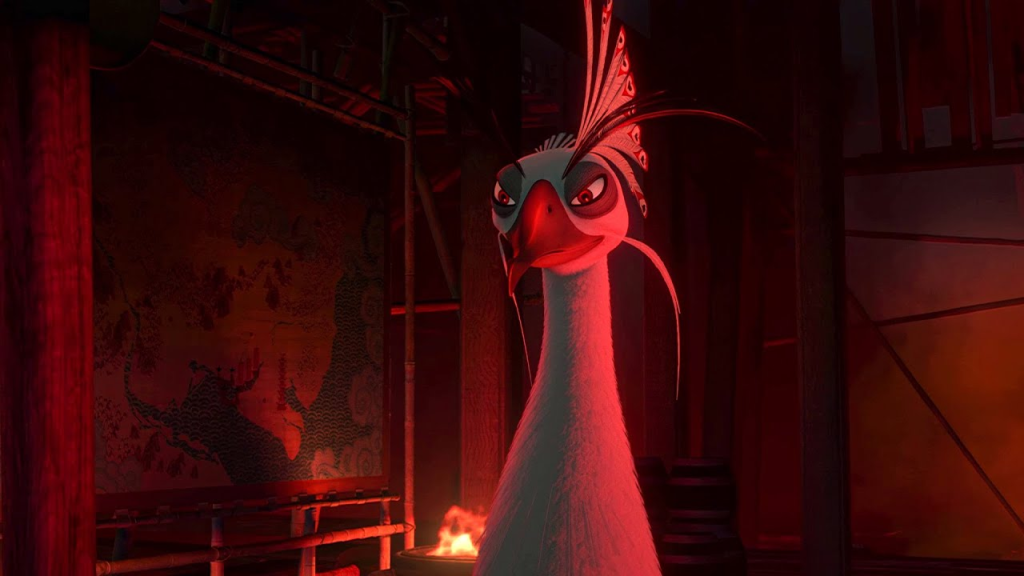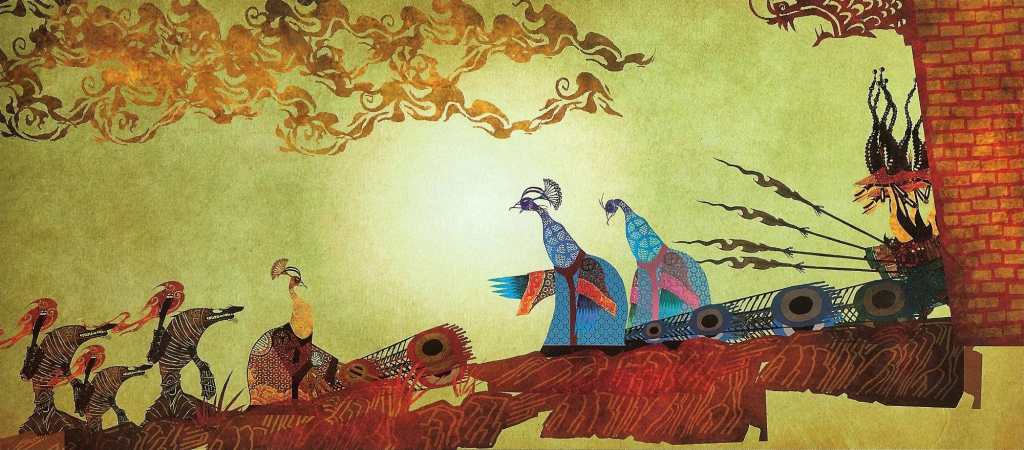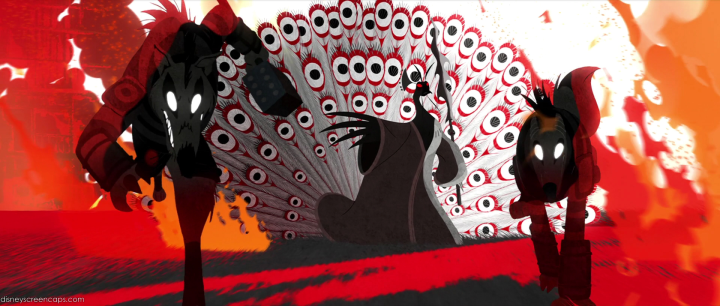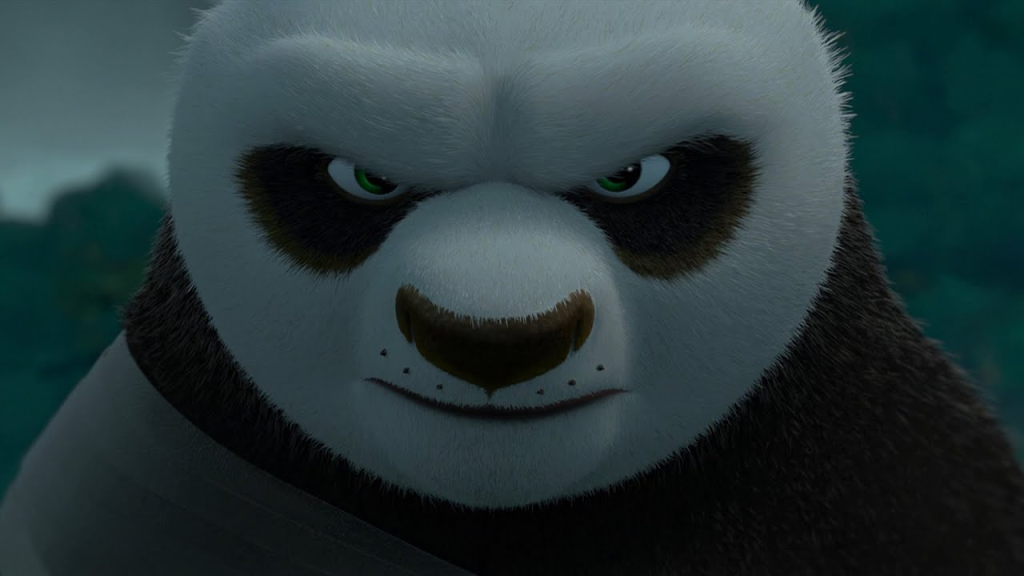
If there’s one thing that stuck with me throughout my viewing of Kung Fu Panda 4, it’s how the movie kept reminding me why the initial idea of Kung Fu Panda was mocked to begin with. That premise alone gives the indication that a panda voiced by Jack Black learning kung fu would basically play out as just being a typical slapstick comedy with dumbed down humor made for the littlest of kids, paint-by-numbers storytelling, and the most predictable reveals and morals imaginable. However, the greatest thing about the Kung Fu Panda movies up to this point is how it takes those “judging a book by it’s cover” expectations and cleverly subverted it into something better, smarter, and greater than it had any right to be. While I’m sure there were intentions of that for this latest installment with the Skaddoshinator (I promise that is the only time I will say that!), Kung Fu Panda 4 is basically the exact kind of movie we thought we were getting from this series from the very beginning.
The idea of a Kung Panda 4 was certainly not one that felt necessary but there were plenty of ways that another entry could work. While Kung Fu Panda 3 did bring a satisfying conclusion to Po arc’s in becoming the Dragon Warrior that he had always dreamed of, there was never a feeling throughout the third movie that it was the absolute endgame for the series. A third movie could be a fine stopping point but there was definitely another train coming along the way if anyone wanted to take it. And DreamWorks decided to take that train with Kung Fu Panda 4. I only wish they found an actual reason to want to hop aboard it.

Premise: Time has passed since Kung Fu Panda 3 and Po (Jack Black) finds himself on his last remaining days as The Dragon Warrior. Shifu (Dustin Hoffman) is ready to promote his panda apprentice to being the Spiritual Leader of the Valley of Peace, the highest ranking of all kung fu mastery. Before he does that, Po must choose a worthy successor to take the mantle of The Dragon Warrior.
However, a new deadly foe has emerged with a new shapeshifting sorceress known as The Chameleon (Viola Davis). The Chameleon is someone that has had her own ambitions of wanting to learn kung fu but never got the proper respect to be able to learn it. Because of that, she wants to take matters into her own hands and copy the kung fu from other notable warriors in the series rose gallery such as Tai Lung (Ian Mcshane), Shen, and Kai to become the kung fu warrior she has always inspired to be.
With the Furious Five not being available due to going on their own personal missions and Shifu supposedly aging, it’s up to Po to stop The Chameleon. However, he can’t find the sinister lizard without the aid of a wanted fox thief named Zhen (Awkwafina), who supposedly knows The Chameleon’s location and promises Po she can lead him right to her front door. Po and Zhen go on a journey together to put the new villain out of commission, where the former comes to the realization this might be his final adventure with The Dragon Warrior title and the latter wondering what side she’s actually fighting for.
Oh, and also Po’s two dads, Mr. Ping (James Hong) and Li Shan (Bryan Cranston), follow their son without him knowing because they are so worried that their son, who had already beaten the biggest named opponents out there up to this point, can’t handle a fight against this newest opponent for some reason.

When reading through that plot synopsis, it basically gives you the indication of where Kung Fu Panda 4 head is at every step of the way. Yes, Po has to learn to take his next step in life. Yes, he realizes he has a lot in common with his new wolf companion and new lizard foe than he initially thought. Yes, he has to learn the true meaning of change. And yes, who Po chooses to be the next Dragon Warrior is obvious the moment that character arrives on screen. However, whereas prior Kung Fu Panda movies were able to take familiar stories and add enough layers to it to make them stand out as fresh and unique tales, the plot of Kung Fu Panda 4 can be read like a book that you predict the expected beats five to ten pages in advance.

As I stated in the plot summary, The Furious Five are nowhere to be seen throughout the main film. Yes, there is an explanation given of their absence in an (admittedly) nice 2D animated sequence and they do show up right when the credits start to roll, but they have no presence in the story whatsoever. Whether this was because they wanted to put the spotlight on the new characters or the fact that the studios couldn’t afford to have Angelina Jolie, Seth Rogen, and crew return due to the film’s shockingly low budget is beyond me but fans who were hoping to see them in action in this one will be severely disappointed.

The newest player this time around is Zhen, played by Awkwafina. On paper, this casting make sense. The crew clearly wanted to hire a celebrity actress that has the same range of comedic chops as Jack Black provides to the titled panda himself. However, the reason why Jack Black has always been perfect as the character is how he is able to perfectly mirror the appearance of a fat comedic panda while still nailing the dramatic beats when needed.
Zhen doesn’t have that same gesture as she is just as feisty, parkour, and can handle herself in action as much as Po or even Tigress can. She basically plays out exactly how other characters voiced by Awkwafina have with nothing new added. She is yet another side character that’s snarky, wise-cracking, and might just have a heart of gold underneath. It’s not that the character herself is inherently bad but she’s not interesting enough to warrant having other characters being purposely written out just to make room for her. Zhen is mostly just your average “grey” character and doesn’t offer much to the Kung Fu Panda universe that other better characters in the series haven’t provided.

The main villain of The Chameleon does feel like more fitting character in concept but still feels like wasted potential. While she certainly has a resemblance to Kung Fu Panda 3‘s antagonist with Kai, with gaining the abilities of other notable kung fu warriors, her whole parallel with Po is the one aspect that Kung Fu Panda 4 provides that feels new and refreshing. Both of these characters were underestimated by society due solely to their appearances but went on to accomplish greater things. Whereas Po went on to become the greatest hero, The Chameleon went on to become the greatest villain. The perfect good guy/bad guy dynamic is right here and could be possibly the most compelling one in the series to date if enough time and care was given into it.
Unfortunately, just like with the most interesting ideas in the film, it doesn’t have much interest in exploring it. This matter is just addressed in a dialogue exchange or two and never is given much focus on beyond that. The character herself basically comes across as an excuse to revive other notable bad guys in the series in the hopes that would get more butt in seats.
It’s also strange how The Chameleon claims to have been denied of learning kung fu due to being “too small” despite one of the Furious Five members being Mantis, A.K.A. a literal grasshopper! I guess kung fu warriors are just as racist towards lizards as pandas.

When it comes to the returning antagonists of the series, Tai Lung is the only one that gets enough screen time to warrant being considered an actual role in the story. And by that, I mean he gets a decent action sequence and a couple of laughs and that’s basically it.
The other notable ones are just there for the sake of continuity and nostalgia, with Ian McShane the only one reprising his role. Not to mention, the scenes where Po is witnessing all of his foes in the same place but Tai Lung is the ONLY one that actually speaks is LAUGHABLY noticeable!
I don’t know if this was yet again done due to a lower budget or there was suppose to be an actual arc for Po’s first foe early on in development (which there really isn’t) but those who were hoping that the villains would get the Spider-Man: No Way Home treatment are destined for disappointment as well.

Perhaps the biggest disappointment of Kung Fu Panda 4 is the way it handles the humor. If you are someone that felt that Kung Fu Panda 3 went too far with its slapstick humor, it’s unfortunately just like that here but even worse. There’s too many jokes that feel extremely forced and are just not funny at all. Too much of the humor feels like it’s only there to keep the toddlers entertained and not because it works in the heat of the moment for the characters. Yes, all of the Kung Fu Panda movies have plenty of humor but they always felt perfectly timed and made sense for the characters without feeling out of place.
With Kung Fu Panda 4, the jokes are nonstop and feel like they are only there because the writers couldn’t figure out how to keep the main story engaging so they just threw in some random jokes in the hopes that it would be good enough to push the whole thing forward. It’s like the worst kind of humor in Marvel movies increased ten fold. There’s only so many times where you can hear Po say skadoosh without it getting tiring real quick.

To gain to the more positive side, the animation is quite breathtaking, which is all the more impressive considering the film’s 85 million dollar budget. Everything looks bright and colorful, able to expand on the same art style from the previous three films while being able to modify it for this to be far in a way the best looking Kung Fu Panda film to date. All the locations of new and old are beautiful to look at, especially the scene with Po in the valley of peace. Even the distractingly out of place models for all the new characters (which feel like they came straight out of Zootopia) can’t take away from this film being a visual treat for the eye.

The action scenes themselves are as dynamic as you would hope for in a Kung Fu Panda movie. It still has that sense of choreography, rhythm, and pace that has always made the fight sequences in this series stand out as well as they do. I enjoyed some of the earlier bits of Po guarding the valley of peace along with the scenes involving him and Zhen fighting together or against each other. While I can’t think of a set piece here that holds a candle to the best ones in the previous three films such as the fights with Tai Lung and Shen or the one between Po and Shifu, along with wanting more lasting action in the climax, they do deliver when it counts the most.

The voice cast is able to do the best with what they have. Jack Black is as perfect here as Po as he always has been, clearly bringing so much love and passion to our favorite panda. Viola Davis gives a great and menacing voice performance as The Chameleon, making the character stand out more than the script will actually allow her. It’s neat to see Ke Huy Quan get a voice over role here for a character that feels like a mix between his characters from Loki and Everything Everywhere All At Once. Dustin Hoffman has shown age as much as the character of Shifu himself (Then again, the man is 86 years old!) but still fits the role like a glove all the same. Ian McShane seems excited to be back as Tai Lung, even if his role isn’t as big as I hoped it would be. Even James Hong and Bryan Cranston are able to get moments to shine in the film’s few funny moments as the two fathers of Po. And as I said before, Awkwafina as Zhen plays out exactly as you would expect a character voiced by Awkwafina to play out, so take that as you will.

I imagine there will be plenty of people reading this review that think I’m being too harsh and overly critical of a movie clearly designed for children. If you think that, that’s completely fine but Kung Fu Panda to me has always been much better than that.
The series’ greatest trick in the past was having you thinking it would play out like your stereotypical “critic proof” movies for kids but when you watch the movies themselves, there is something much more than that. Kung Fu Panda 4 feels more in line with what the series was originally thought of as being on the surface level, almost as if it was made by Illumination than DreamWorks.
For those that come to these movies for the action and some laughs, you might get your money’s worth. It’s competently made with solid animation, fight scenes, and voice work throughout but the clever storytelling and engaging resonate themes are just not there this time around.
There are moments where it feels like it’s going to get there and makes this stand proudly with the other three films but it instead chooses to take the quick and easy path every step of the way, which is not how the series was up to this point. It’s odd how for a movie that claims to be about change, it does very little of that to its overall status quo.
I don’t know if it had to do with a supposed rushed development, lower budget, or running out of creative gas but Kung Fu Panda 4 feels like it was only made to keep the franchise brand going and not because anyone had a unique enough story to tell for it.
If the series continues to stick to it’s initial six-movie arc plan that DreamWorks envisioned back in 2010, then they better find a way to spice things up for parts five and six if they want anything after Kung Fu Panda 3 to be worthy of existing.
As an animated film for kids, it’s passable at best. As a Kung Fu Panda movie, there’s just not enough skadoosh this time around.
Other comments:
- Yes, Jack Black’s version of Baby One More Time is awesome and the biggest standout of the entire soundtrack.
- There is actually a scene in the movie where Bryan Cranston has a little Walter White in him as Po’s biological father.
- Who in a million years would have thought that Puss in Boots: The Last Wish would be by far the best DreamWorks sequel in recent memory and NOT Megamind 2 or Kung Panda 4?
- Yes, I watched Megamind 2. It’s probably the most pointless sequel I’ve ever watched!
- Oh and Mr. Beast makes a voice cameo in this one! That’s cool I guess!
- Also, Po’s dads are so gay! Just saying!

